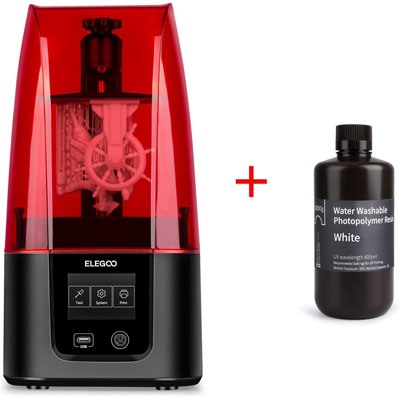The Sonic Mini 4K and Mars 3 are both compact, desktop 3D printers that offer 4K resolution on prints. While they are both innovative and boast many technological features, we will be breaking down the differences between the two printers to help users select the one that is most suited to their needs. Our recommendation will be based on the user’s skill and project needs.
Phrozen Sonic Mini 4K
The Sonic Mini 4K is a lightweight and compact 3D printer option. It boasts features like extremely high resolution, easy assembly, and very high resolution.
The Sonic Mini 4K offers a resolution of 3840 x 2160 pixels. The XY-resolution of the printer comes in at 35 microns. It offers a layer height of 10 microns. The printer also boasts high-speed levels of just 2 seconds per layer. This speed comes from the use of a monochrome LCD, which allows the resin to be hit by more UV light, curing it faster. This model uses ChiTuBox software, which allows for support from the community of Sonic Mini 4K users.
The machine comes fully assembled but requires manual bed leveling before it can be used. This step can take some work as it requires the adjustment of four screws, but it should only have to be done once. The printer offers a metal vat for the resin and an angled top surface that allows the excess resin to run off after printing is complete.
One downside to the Sonic Mini 4K is that Phrozen requires a very specific resin to be used to achieve high-quality models. There is also no easy access to the printing area, the entire lid has to be lifted off to start printing or once printing has been completed.
ELEGOO Mars 3
The Mars 3 printer is a compact resin printer offering 4K resolution. It sports features like plug-and-play design, high resolution, and easy assembly.
Like the Sonic Mini 4K, the Mars 3 offers a 4K monochrome LCD screen, which allows the printer to print at a resolution of 35 microns. Additionally, the two printers compare in that they are both pretty much ready to use straight out of the box. Like the Sonic Mini 4K, the Mars 3 comes with a USB stick that is preloaded with ChiTuBox software. Both printers require information to be transferred via a USB port as network connectivity is not supported. As uncured resin is unsafe to work with, both printers also come with personal protective equipment like masks and gloves.
Unlike the Sonic Mini 4K, calibrating the Mars 3 is a lot simpler as it uses a ball and socket design that only requires the tightening of two screws. The build volume on the Mars 3 is larger, offering the ability to produce more complex models in a single piece. The Mars 3 has a slightly slower cure time per layer at 2.5 seconds.
The Mars 3’s masking LCD system offers a resolution of 4098 x 2560 pixels. The printer also uses an FEP film with a thickness of 0.127 mm, which, combined with the sandblasted surface of the build platform, allows for better adherence of models. The printer also comes with a 1-year warranty.
The printer’s vat does not offer a pour spout, making it difficult to pour out the remaining resin at the end of a print cycle. The bottom of the printer is made from plastic whichmakes it feel less than sturdy.
Conclusion
While both 3D printers offer high resolution and excellent technical specifications, we must break down the differences so that users can make the best choice before committing to the purchase of either printer. The Sonic Mini 4K offers high resolutions at fast speeds. Because of its ease of use and high level of detail, this printer is suitable for both hobbyists and professionals. However, newer users may find that the calibration process is too complex for them.
On the other hand, the Mars 3 printer offers ease of use along with a simple calibration process, making it an option for newer users. High resolutions and the ability to print larger complex prints additionally make this printer ideal for hobbyists and professionals.

